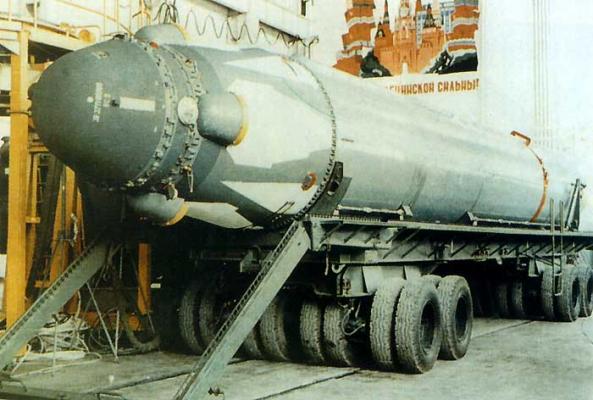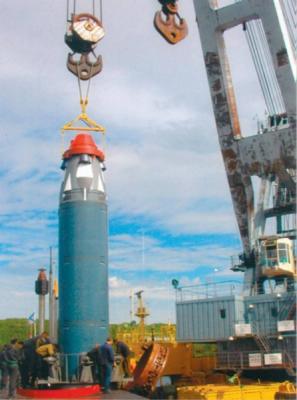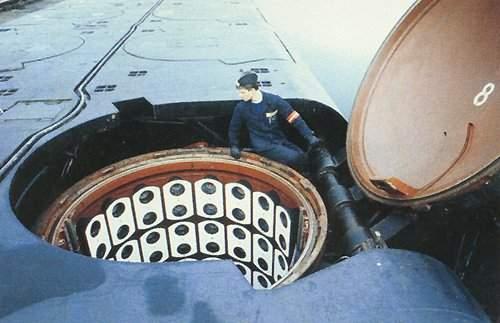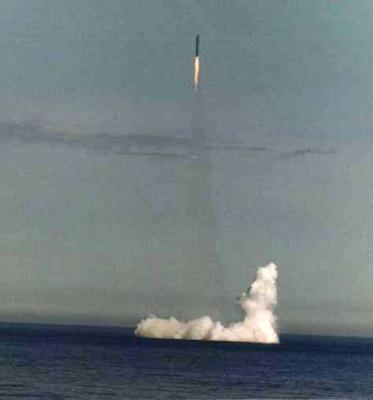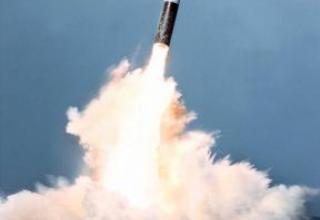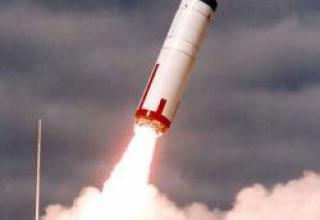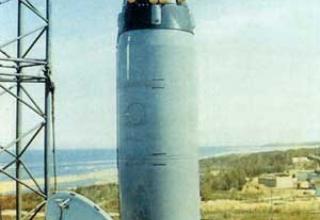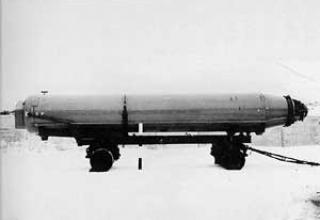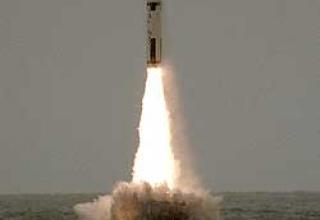In 1979, the Design Bureau of Academician V. Makeev began work on the design of a new intercontinental ballistic missile R-29RM (RSM-54, 3M37) of the D-9RM complex. The task of its design was to create a missile with an intercontinental range capable of engaging small protected ground targets. The development of the complex was focused on achieving the maximum possible tactical and technical characteristics with limited modification of the submarine design. The assigned tasks were solved by development of the original three-stage missile circuit with combined tanks of the last march and combat stages, use of engines with limit characteristics, improvement of the missile manufacturing technology and characteristics of the materials used, increase of the missile's dimensions and launch weight due to the volumes that fall on the launcher when they are jointly configured in the submarine's missile shaft.
A significant number of new missile systems were taken from the previous modification of the R-29R. This made it possible to reduce the cost of the missile and reduce development time. The development and flight tests were carried out according to the proven scheme in three stages. The first stage involved the use of layouts of rockets launched from a float stand. Then joint flight tests of the missiles started from a ground test bench. At the same time, 16 launches were made, 10 of which were successful. At the final stage, the lead submarine K-51 "Names of the XXVI CPSU Congress" of project 667BDRM was used.
The D-9RM missile system with the R-29RM rocket was adopted for service in 1986. Ballistic missiles R-29RM complex D-9RM armed with SSBNs pr. 667BMBM of "Delta-4" type. The last boat of this type K-407 entered service on February 20, 1992. In total, the Navy received seven missile carriers of project 667BMBMBM. They are currently in combat service with the Russian Northern Fleet. Each of them accommodates 16 RSM-54 launchers with four nuclear units on each of the missiles. These ships form the backbone of the maritime component of the SNF. Unlike previous versions of the 667 family, Project 667BM boats can launch a missile in any direction relative to the ship's course of travel. The submarine launch can be carried out at depths of up to 55 meters at a speed of 6-7 knots. All missiles can be launched in one salvo.
Since 1996, production of RSM-54 missiles was stopped, but in September 1999, the Russian government decided to resume production of a modernized version of RSM-54 "Sinev" at the Krasnoyarsk Engineering Plant. The principal difference between this machine and its predecessor is that it has changed the size of its steps, installed 10 nuclear individual guidance units, increased protection of the complex from electromagnetic pulse action, installed a system to overcome the enemy's anti-missile defense. This missile incorporated a unique satellite navigation system and a Malachit-3 computing system, which were designed for Bark ICBMs.
On the basis of the rocket R-29RM created a launch vehicle "Stil-1" with a mass of 100 kg. With its help, for the first time in the world, an artificial earth satellite was launched from the PL. The launch was carried out from an underwater position.
In the west the complex was designated as SS-N-23 "Skiff".
Composition:
P-29RM is a three-stage rocket with sequential arrangement of steps made according to the "compacted" scheme. As the marching engines on all stages "recessed" in tanks ZHRD with high traction characteristics are applied. In the front part of the rocket there is an instrument compartment with a control system, including equipment of astro-correction of the flight path according to the results of measuring the coordinates of navigation stars, equipment of radio-correction according to the results of information exchange with navigation satellites and combat units (see the scheme).
The missile casing is made of an all-welded aluminium-magnesium alloy. For docking the missile to the launcher, the missile's tail is equipped with an adapter-support band. At missile launch, the adapter remains on the launch table. The first stage engine (see photo) consists of two blocks: main (single-chamber) and steering (four-chamber). Control forces through the channels of pitch, yaw and roll are provided by turning the combustion chambers of the steering unit. The pulling force of the first stage is 100t.
The second stage enclosure shall consist of an oxidizer tank connected to the first stage enclosure and a fuel tank, the front bottom of which shall be in the form of a tapered niche used to accommodate combat units and the third stage engine. The second stage engine is single-chamber, and its main units are located in the oxidizer tank of the first stage. The control forces along the pitch and yaw channels are created by turning the combustion chamber fixed to the cardan suspension, and along the roll channel by turning the roll block.
The engine of the third stage is single-chamber. Control forces on the third stage through all channels are created by a two-mode engine for the spread of combat units, which operates simultaneously with the engine of the third stage. The third stage engines and the head unit are combined in a single assembly with a common tank system (see photo).
The first and second, second and third stages are separated by a system of detonating elongated charges.
The head part is four- and ten-block with individual pointing of blocks. It is possible to equip the missiles with a shrapnel-flash BC with the weight of BB about 2000 kg, designed for ultra-precise hitting targets in a non-nuclear conflict. It is also considered possible to arm NSC missiles of svermall- caliber (TNT equivalent up to 50 t) designed for "spot strikes". The warhead deployment zone is arbitrary and variable in terms of energy. Under the START-1 treaty, only four-block RSHs are installed on R-29RM missiles.
In addition to astro-correction equipment, the high-precision control system has equipment for correcting the trajectory of the Hurricane system's navigation satellites and provides the KVO for firing at a maximum range of about 500 meters. It is possible to use different types of flight trajectories at minimum and intermediate ranges.
Compared to the P-29R, the missile diameter has slightly increased, but the SSBN shaft diameter has not increased. The combat effectiveness, as compared to the R-29R, has considerably increased. The conditions of missile combat application have been expanded due to the possibility of using the missiles from high Arctic latitudes. The R-29RM is not inferior to the heavy missile of project 941. At the same time its launch weight is more than 2 times less than that of the R-39 with the same range of fire.
RSM-54 is the best ballistic missile in the world by energy mass perfection. By this term, the designers understand the ratio of the ballistic missile's combat weight to its launch weight, which is reduced to one flight range. For example, if a vehicle throws one weight of a combat unit at a range of 8 thousand kilometers, then to solve the same task at a range of 10 thousand kilometers it will be necessary to reduce the weight of the combat load. If we evaluate our missile by this indicator, the RSM-54 has 46 units. This is better than the American sea-based ballistic missiles Trident-1 and Trident-2, which have energy masses of 33 and 37.5, respectively.
Characteristics:
| Start mass, t | 40.3 |
| Maximum mass to be thrown, kg | 2800 |
| Maximum firing range, km | 8300 |
| Firing accuracy at maximum range (CVO), m | 500 |
| Number of steps | 3 |
| The length of the rocket, m | 14.8 |
| Diameter of the first and second rocket stages, m | 1.9 |
| Diameter of the third rocket stage, m. | 1.85 |
Testing:
On August 6, 1991, at 9:07 p.m., salvo fire was fired with a full set of RSM-54 missiles from the 667BMBM submarine. The operation received the code "Begemot". In order to reduce costs, the operation was carried out for scheduled combat training of the submarine crew and regular flight of only two missiles. The missiles, which started in the first and last volley, had to complete the full flight program and hit the specified aiming points. The other missiles taking part in the salvo should have fully corresponded to the combat missiles in all the launch parameters, but the height of their flight could be arbitrary. To carry out the volley full ammunition was allocated submarine Novomoskovsk (commander of the boat SV Egorov) and 16 missiles RSM-54, manufactured by the Krasnoyarsk Engineering Plant. The launch was a success, so far no one in the world has been able to repeat the firing with full ammunition.
On June 5, 2001 the Northern Fleet's 667BMBM project (commander - 1st rank captain Mikhail Bannykh) successfully launched a ballistic missile from the Barents Sea. The missile was launched from an underwater hollow. The head of the rocket at a given time hit the target at the Kura test site in Kamchatka.
Sources:
- www.flot.com
- Баллистическая ракета Р-29 комплекса Д-9 /Подводный флот СССР и России
- В.П. Кузин, В.И.Никольский Военно-Морской Флот СССР 1945-1991. СПб, "Историческое Морское Общество". 1996
- А.Б. Широкорад Оружие отечественного флота 1945-2000. Минск,Москва, Харвест АСТ, 2001
- Ильин В.Е., А.И. Колесников Подводные лодки России: иллюстрированный справочник. Тверь, Издательство Астрель, 2001
- http://makeyev.ru/activities/missile-systems/3/RaketaR29RM/
